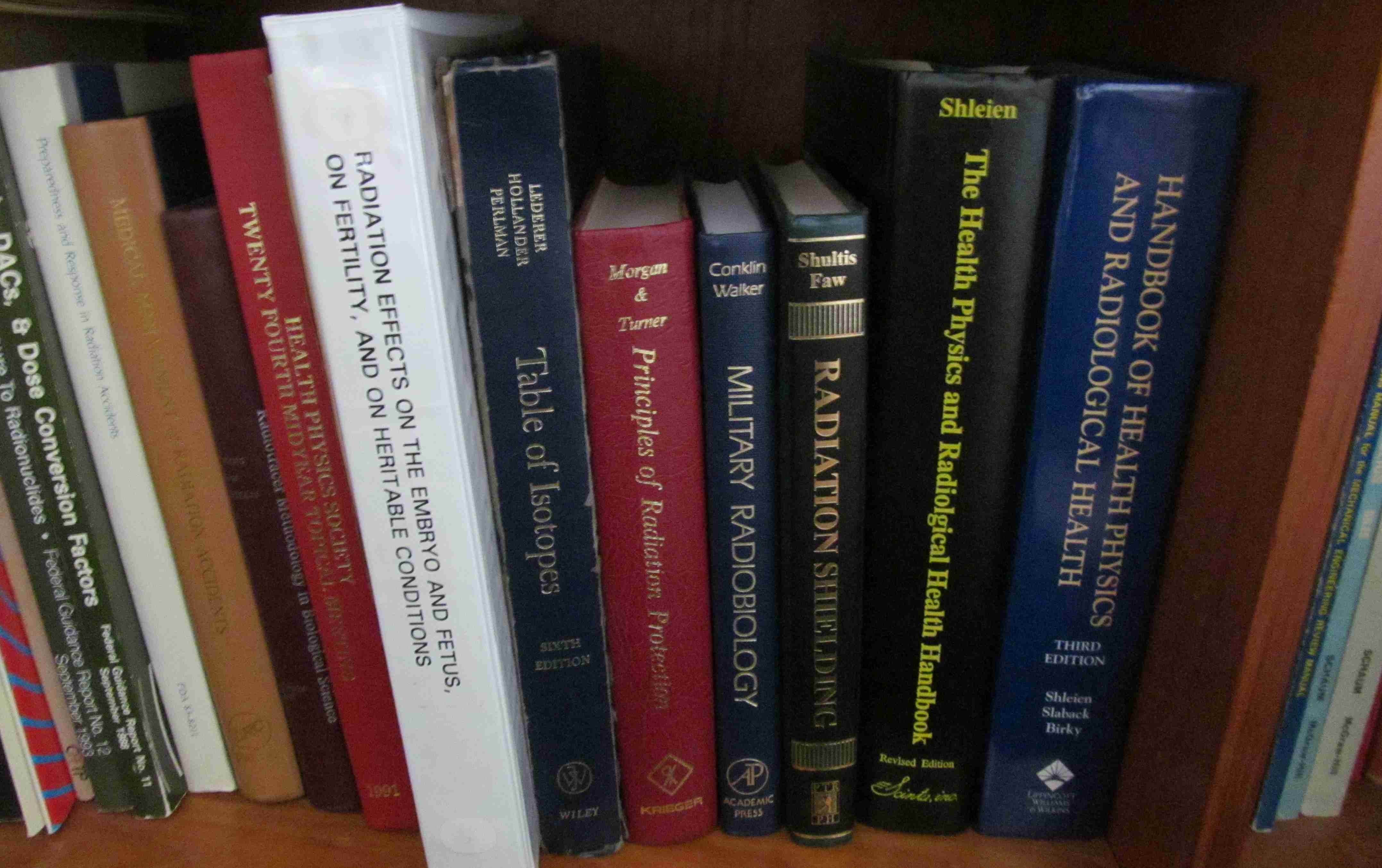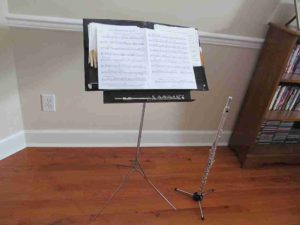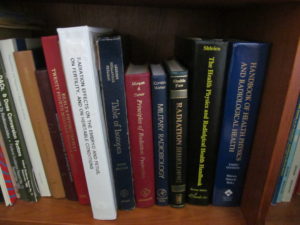In 1989, after thirteen years working in the nuclear power plant design field as a radiation shielding engineer in Chicago, I realized that the bottom was dropping out of the power plant market following the Three Mile Island accident. My group of radiation shielding specialists was being laid off one by one, so before that happened to me I sought other employment. I was hired by Oak Ridge National Laboratory (ORNL), a government research and development facility, as a radiological engineer and health physicist (the latter title indicating a professional radiological protection specialist). My family and I moved to Oak Ridge, Tennessee and I began work in November 1989. My area of emphasis in both my old and new jobs was radiological safety, specifically the protection of workers and the public.
Early in my tenure at ORNL, someone who had also previously worked in the nuclear power field commented on difference between the nuclear power regulating agency – the Nuclear Regulatory Commission (NRC) – and the national laboratory and weapons production facility regulating agency – the Department of Energy (DOE): he said that whatever one thought about the NRC, the NRC guys would seem to be a very sane, rational, and reasonable bunch compared to DOE. I found that to be so. DOE was a very politicized agency whose priorities were not always its ostensible aims, which were the conduct of scientific research, the production of nuclear weapons, and the safety of workers and the public. Consequently, it seemed to us safety people that decisions were often being made on arbitrary and irrational bases; we sometimes would find out who had made the decision and why, and sometimes we would not. Occasionally it would turn out, for example, that some congressman or other high muckety-muck had gotten on DOE’s case and DOE would respond by going overboard on some issue or another. Sometimes DOE would impose requirements allowing it to micromanage safety and sometimes it would back off almost completely to a laissez-faire stance.
But from about 1995 until December 2000, when I was laid off with about two hundred others at ORNL, an additional difficulty arose. The short version of what happened is as follows. Bolstered by yet another one of DOE’s inept attempts at improving safety and operational management at all its sites around the country, operational management at ORNL (run by a contractor) felt itself empowered to take control of the safety organization. Their rationale was that since the DOE money came to the safety organization through the operational entities (including the research entities), these entities were in effect the “customers” of what I call the institutional safety organization. That opened the door to the claim by the operational entities that they controlled safety at all levels – or else. The “or else” was the threat of outsourcing safety functions to subcontractors, who would be more accommodating to operational management’s need to meet milestones and deadlines and to reduce costs. This to us safety people meant that the fox was guarding the henhouse.
My group, the ALARA support and radiological engineering group, was a particular target of the operational organizations. ALARA means “as low as reasonably achievable” and it refers to the effort to reduce radiological dose, both from external and internal sources. Many people in the operational and research entities thought that ALARA was a giant boondoggle: they believed that DOE was placing undue emphasis on reducing dose because the entities regarded the doses their people received as safe and so it was stupid to make a time- and money-consuming effort to reduce them. DOE certainly did some ridiculous things in the name of ALARA, but for the most part the reduction efforts were in line with the thinking of the national professional organizations and the practices of the NRC regulatees. That is, simplistically, in terms of eventual production of cancer, the action of radioactive agents in industrial settings was mostly stochastic (i.e., statistically random in nature) and so reducing doses to quite low levels was thought to be worth it in terms of lives saved.
Many of the operational managers thought that they could do most safety work themselves or by using one or a few in-house people. One researcher remarked to me bitterly that “we know how to work safely”, meaning that no nosy safety people needed to intrude on and, in his view, try to control the operational entities’ work. Some large divisions had a small in-house safety group, which answered directly to the division manager or one of his deputies and which might be broadly trained in industrial hygiene, radiological safety, industrial safety, and ergomics. The lead in the group might have a degree, but usually most of the group did not. So the safety professionals in the institutional safety organization were looked upon as “charge by the drink” people who in providing oversight and advisory services soaked up operational funds uselessly. Although when I started to work at ORNL the institutional safety organization had its own funding and did not need to charge for its services except in special cases, eventually that base funding was reduced and the safety people did indeed have to charge for most of their services.
This worked reasonably well for the radiological technicians in the safety organization because they were typically assigned to a particular operational area or entity and spent all their time on the work of that entity. They tended to identify with the operational entities they worked for, and vice versa. But for the radiological engineers, who were professional health physicists, that was not true; we usually were called upon as needed or as per procedure, i.e., intermitttently. So in time our work was regarded as mostly unnecessary and we were thought of as parasites. Once the operational entities took charge of the funding, the attitude of the operational people toward us became more and more one of irritation and even outright hostility.
In our own organization, my group faced opposition and resentment from the radiological technician suborganization. In my early years at ORNL, the techs regarded the professional health physicists as not being in touch with the real world of operational work, but they did have respect for the older health physicists and they were seldom overtly disdainful. But this began to change when one radiological tech supervisor was hired. He had a degree and had done some radiological engineering work, I believe. But he turned out to be a super-schemer: he eventually had his own group leader forced out by getting his people to turn on the group leader and he took over the group leader position. He persuaded the operational managers in his area that the rad techs and their supervisors could provide all the radiological safety services the managers needed and were cheaper and more cooperative to boot.
For example, a rad tech assigned to an area was always at the manager’s beck and call and on any given day he worked on what the manager wanted him to. On the other hand, if the radiological procedures called for a review of an operation or task because of the level of dose involved, the manager could not always get the radiological engineer to drop everything else he had on his plate and hie at warp speed over to the reactor, or the hot cell, or wherever. As time went on and DOE pressure mounted to work faster and more cheaply, the operational entities began to do more by the seat of the pants, i.e., on an ad hoc basis as allowed by the increasingly more vague and loosey-goosey procedures, and these entities’ perceived need for an immediate response from us became a source of great stress for us but of great leverage for the rad tech group leader.
An example of this is the time that my supervisor (the ALARA group leader) and I went over to the reactor for a meeting. There somebody asked us if we were there to watch the job that was about to begin. We said that we had heard nothing about it, which puzzled our informant, who recognized it as involving a dose rate that I, by procedure, was supposed to review. But I had received no request for a review. We inquired into this immediately and found that the rad tech group leader had signed the Radiological Work Permit in the spot where my signature was supposed to go. This was an egregious violation of procedure, but although he admitted that, he was unrepentant – he hadn’t wanted to make the operational people wait while they contacted me to come over. As far as I know, he was never reprimanded or called to account in any way by operational management or by the radiological safety organization, except to say (nod, nod, wink, wink) that he shouldn’t do it again.
We in the radiological engineering group attended professional conferences and meetings and thus had the opportunity to talk with our peers and see other DOE sites. It was clear to us that the way we were treated, both by the operational entities and the radiological technicians, was not the norm DOE-wide (and also, as a rad tech who had worked at a nuclear power plant told me, not the norm at power plants either). At ORNL, a way had been found to squeeze us into a tightly restricted little corner by control of the funding and its consequent deathgrip on our management. My manager three steps up (i.e., my supervisor’s boss’s boss) told me explicitly that we had to knuckle under and keep operational management happy or our jobs would be outsourced to others. The higher safety managers were over 50 years old and keeping their jobs was important to them for reasons of financial security.
The knuckling-under included putting up with several instances of harassment that at other places would have resulted in the firing of the harasser. The rad tech group leader once put an amended cartoon that insulted us on the doors of my group’s offices while we were at a meeting, a cartoon that everyone who passed along our corridor would see. A few days later, I was discussing another subject with him on the telephone and when our discussion concluded I asked him if he was the one who had posted the cartoons. I really did not think he had done it, so I was surprised when he said he had done it. He was not at all apologetic about it. I believe that he thought, correctly, that he would not be punished for it. I told my supervisor about his confession and she passed it along to higher management. In fact, he did not appear to suffer any repercussions about it. One of his rad tech supervisees forged my name to an E-mail message (this was before E-mail systems became as secure as they are today) and sent it to a buddy of his. The message contained an insult, purportedly from me. We would never have discovered this except that the offender mistakenly sent the message to me. Our divisional computer person investigated it and the rad tech was made to offer me a grudging apology to me, but that seemed to be the end of it; the offender was not sent home for a day, for example.
Over time, responsibilities and involvement in operations was stripped from my group more and more. One example that I think lay people can understand is very telling. DOE directed that all sites revise their procedures to conform to its new Radiological Control Manual. In the manual, it was stated that jobs should be given an ALARA review (by professionals) at a trigger dose rate, which should be no more than 2 rem/hr, with .5 – 1 recommended. ( A rem is a unit of radiation dose.) However, despite what the manual said, it was regarded as guidance and so a site could choose any number it wanted, up to 5 rem/hr. Every other DOE site we checked (which was most of them) had 1 or less, except for perhaps one with 1.5. But ORNL choose 5 rem/hr. As my group leader and her manager pointed out, if you were trying to keep the dose down to, say, .5 rem, then the worker could be in the 5 rem/hr dose rate for only 1/10th of an hour, or six minutes. There are various considerations in work planning here that I won’t go into, but the stark nature of the 5 for us versus less than 2 for everybody else as the trigger level for a review shocked us. However, it didn’t seem to faze our local DOE office at all.
I lost the radiological engineering interface responsibility with the reactor operations people, an assignment I had had for about 10 years in various forms. There was a big reactor operation scheduled for 1999 that would involve months of planning and weeks of execution. The rad tech group leader persuaded reactor management to insist that the least experienced one in our group be appointed as the radiological engineering reviewer of the job; they were friends and this radiological engineer was known to be very cooperative with operational management. The review function involved reviewing or producing dose estimates of the various suboperations. My group leader did make them agree that I would review what the new reviewer came up with during the planning, due to my history with the reactor. Weeks went by during the planning stage and the reviewer did not produce any estimates; he claimed that the operational people and rad techs were not giving him the dose rates.
Finally, almost on the eve of the start of the operation, some dose rates for various suboperations were produced. I took them and, as I was experienced in doing, churned out some estimated doses by job and by type of worker (e.g., millwright). I also produced summations for the worker types so that it could be seen what types of workers and even what individual worker would get the most dose. All this would show where dose reduction might be effective and for whom. At the final meeting of the radiological and operations people meeting the day before the operation was to start, the clueless reviewer of course had nothing to show in the way of dose information. So I produced my writeup, with a useful table broken done by suboperation and worker type. I could tell that the operations manager, whom I had known for years, was impressed and for once I was thanked for what I had done. Despite not doing what a radiological engineer is supposed to do, my colleague was retained as the reviewer for the operation and I was again out.
Eventually the big layoff of 2000 took place. There were 3.5 radiological/ALARA engineers in our group: 3 peons and our group leader (.5, because she split her time between our group and another group). The most experienced two of us were laid off; the one not laid off was….my do-nothing colleague on the reactor operation. In the overall safety organization (including radiological safety and industrial hygiene), the rate of layoff was twice what it was for the rest of the site organization. I did not know in advance that I was to be laid off; it truly was a coincidence that some days earlier I had delivered to the local DOE office a lengthy writeup of what I regarded as violations of DOE regulations and ORNL procedures. I knew, however, that I had been targeted to be fired because of my many efforts on many projects and at many facilities to get ORNL to follow the regs and procedures. This was borne out by testimony at my subsequent DOE whistleblower hearing. I will not detail my whistleblower case here; for that, the reader can look in the various chapters of the book I wrote about it and published online back in 2004. (It is posted by chapter on this page.) Suffice it say that I lost my whistleblower case at the first level (the hearing), but won at the appeals level and again at the Secretary of Enegy level.
But what did I win? I won a chunk of money, but my career was blasted forever. I could have gotten my job back, but with all that hostility no doubt still in place, it would have been hell. Actually, during the settlement talks, it was made clear to me by ORNL management that there was no job to go back to; they had reorganized and allegedly nobody was doing what I used to do any more. Of course that was a lie, but I did not want to go back to a makework job from which, as somebody later pointed out to me, they could make up all the excuses they wanted to fire me. Further, ORNL did not have to change anything at all: what was litigated was the pretextual firing of me, not whether or not ORNL violated any safety regulation. Local DOE was happy with ORNL, so that was that – I never actually got to make my arguments about the violations to anybody at, say, the national level of DOE.
But worst of all, as I found out through a Freedom of Information request, your tax dollars and mine paid for half my settlement. Yes, you read that right. I think it was illegal for them to do so, but DOE agreed to pay half and I have the letter that proves it. The rationale was that the contractor threatened to take the case to the Sixth Circuit Court of Appeals and DOE wanted it to go away. So DOE pressured the contractor to settle and, as an incentive, agreed to foot half the bill. That was so wrong.
About a year after my layoff, I got a low-paid and nonsalaried position in the Radiological Safety Office at the University of Tennessee in Knoxville. That was the only job I ever left without having another job lined up: the boss, hired because the university wanted to keep his crack researcher wife, was abusive to everybody and violated good radiological practice rules right and left. The last straw was when he directed a newly hired and completely untrained rad tech to put up pegs in the kitchen to hang the lab coats we wore into potentially contaminated areas. He laughed when I expressed concern about that.
Less than a year later, I took a job on the Energy Employees Occupational Illness Compensation Program Act (EEOICPA) dose calculation team. Many health physicists around the country were working on this. I had to work from home – no workplace buddies for me – and I felt very isolated. Further, it was in a backwater of health physics, what I called “archaeological health physics” (a term I originated, by the way). That is, we were reconstructing doses for people who were retired or dead and so my work did not affect the radiological safety or health of any worker. Still, with my engineering background and my experience with actual work, I thought I did a good job of digging into the very old records and figuring out who did what work where and for how long. After 4.5 years, however, the government downfunded the project and I was laid off, along with my entire group and, I believe, hundreds of others around the country.
I applied for job after job in operational health physics from my 2000 layoff on, but I never got an interview even when the job description tallied exactly with what I had done at ORNL. After I was laid off from the EEOICPA job, I was never able to find a full-time job again. There were jobs elsewhere in the country, but either I did not get any response to my application or I did not submit an application because the jobs were contingent gigs. That is, they needed somebody with my skills to go to, say, Idaho and work for six months with a possible renewal for six more months and there were no benefits or 401(k). My husband had died in late 2006, about seven months before my EEOICPA layoff, and I felt that I should stay put in Oak Ridge where my emotional support (my son, my band, my cactus club, etc.) were. I worked for free on several job proposals that companies in my area were putting together, but none of these companies won the contract. I did some free-lance rad worker training a couple of times, but when the owner of the company I worked for retired, he closed the business and the training contract went elsewhere.
I had no support whatsoever from my professional society, national or local. I tried to persuade the national society that when the health physics certification body did its annual salary survey, they should include choices for health physicists who were unemployed at the time and not assume that everybody was employed. They said, two years in a row, that they would consider it, but they never did anything about it. My local chapter of the professional society would not allow me to give a talk on my whistleblower experience because it was suggested to the president that if I criticized my former employer (the ORNL management contractor, an important source of employment in Oak Ridge), the chapter might be sued for slander.
Two talks given at local professional society meetings in the years following my layoffs from DOE and EEOICPA just broke my heart. In one of them, a health physicist that I knew described his coverage of a lengthy, difficult, and potentially dose-heavy operation that his employer, a DOE contractor different from the one I had worked for, was hired by DOE to plan and I think perform. Back when I was working at ORNL and this operation was being planned by my employer, I had been consulted about this operation. Among other things, I pointed out that the reach-rod-through-a-hole-in-the-floor method that the operational people were proposing to use would result in a very significant streaming path for the radiation being emitted by the tanks below the floor; for practical reasons, the rod could not be too long and so the worker manipulating the rod would be relatively close to the hole. I suggested some shielding-type fixes and some limitations to enhance worker safety. The response was a resounding silence. By procedure I should have been deeply involved in the planning of this operation, but once I had rendered an apparently unpopular opinion I never heard back from the operational people, nor did they consult my supervisor. I do not know why DOE chose to move the operation from my employer to the other company, but other such moves were on the basis of cost and inefficiency and not, say, on the basis of insufficient attention to worker safety. Regardless, my colleague the health physicist who did get to cover the operation discussed in his talk the measures that he had proposed and fought for – they were just what I had proposed. So he got from his employer what I could not get from mine, the ability to do his job effectively.
In the second talk, another health physicist that I knew described her work on another lengthy, complicated, and potentially dose-heavy operation that her employer, a DOE contractor different from the one I had worked for, was hired by DOE to plan and perform. She described using a very large tent and various other contamination controls of the type that my group and I had proposed over the years and had not gotten implemented. Our failure was mainly due to the rad techs’ opinion, backed up by operational management, that if an idea did not come from the rad tech organization, it was not sensible or feasible. (Yet we were the ones attending all the conferences at which new ideas were discussed.) I was torn as I listened to the talk, proud of her because she was able to do such a good job (again, having sometimes to fight for what she deemed necessary but still listened to) but saddened because I and my fellow group members were not allowed to do the same. I think that my experience should be taken as a cautionary tale for others contemplating becoming whistleblowers. As my late first husband said, I should perhaps have just left my job in the period 1995-2000, when work conditions became intolerable with regard to compliance. The long struggle to get management and individuals to do the right thing and to put people ahead of deadlines was very stressful and wearing. Given that I did stay, I do have my self-respect: I did not sell out or cave in under pressure. Still, I feel that I fell on my sword for the cause of worker protection and I paid a heavy price for it.





